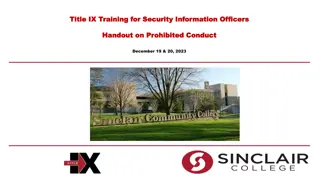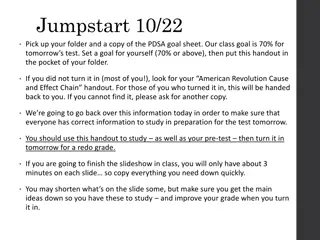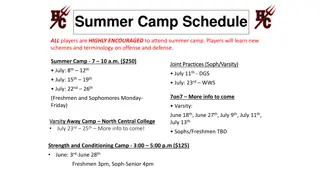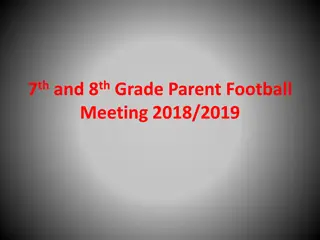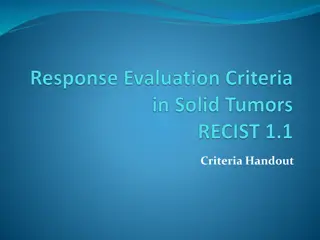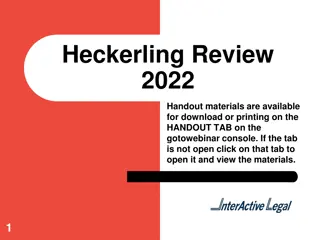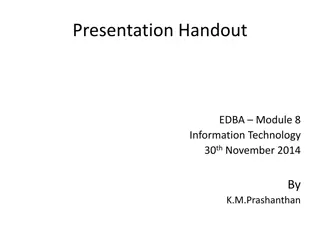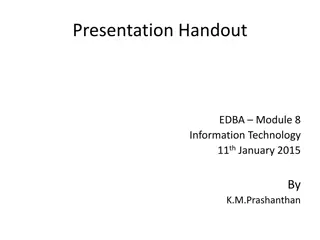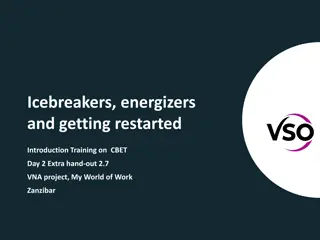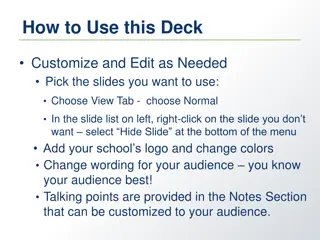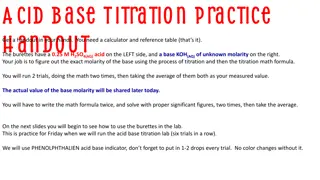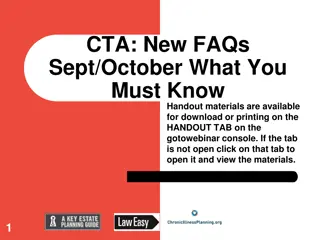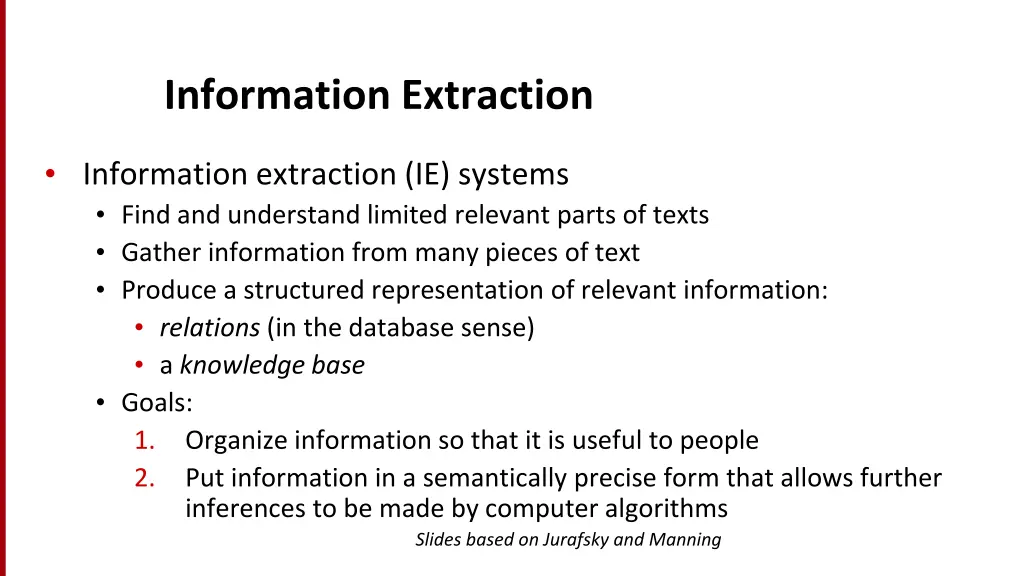
Understanding Information Extraction Systems
Information Extraction (IE) systems extract and organize limited relevant parts of texts to create a structured representation of information for both human and machine understanding. This involves gathering clear factual information and identifying named entities in text. Low-level information extraction is now commonly integrated into applications like email services and web indexing. Named Entity Recognition (NER) is a critical sub-task in this process.
Download Presentation

Please find below an Image/Link to download the presentation.
The content on the website is provided AS IS for your information and personal use only. It may not be sold, licensed, or shared on other websites without obtaining consent from the author. If you encounter any issues during the download, it is possible that the publisher has removed the file from their server.
You are allowed to download the files provided on this website for personal or commercial use, subject to the condition that they are used lawfully. All files are the property of their respective owners.
The content on the website is provided AS IS for your information and personal use only. It may not be sold, licensed, or shared on other websites without obtaining consent from the author.
E N D
Presentation Transcript
Information Extraction Information extraction (IE) systems Find and understand limited relevant parts of texts Gather information from many pieces of text Produce a structured representation of relevant information: relations (in the database sense) a knowledge base Goals: 1. Organize information so that it is useful to people 2. Put information in a semantically precise form that allows further inferences to be made by computer algorithms Slides based on Jurafsky and Manning
Information Extraction (IE) IE systems extract clear, factual information Roughly: Who did what to whom when? E.g., Gathering earnings, profits, board members, headquarters, etc. from company reports The headquarters of BHP Billiton Limited, and the global headquarters of the combined BHP Billiton Group, are located in Melbourne, Australia. headquarters( BHP Biliton Limited , Melbourne, Australia ) Learn drug-gene product interactions from medical research literature
Low-level information extraction Is now available in applications like Apple or Google mail, and web indexing Often seems to be based on regular expressions and name lists
Named Entity Recognition (NER) A very important sub-task: find and classify names in text, for example: The decision by the independent MP Andrew Wilkie to withdraw his support for the minority Labor government sounded dramatic but it should not further threaten its stability. When, after the 2010 election, Wilkie, Rob Oakeshott, Tony Windsor and the Greens agreed to support Labor, they gave just two guarantees: confidence and supply.
Named Entity Recognition (NER) A very important sub-task: find and classify names in text, for example: The decision by the independent MP Andrew Wilkie to withdraw his support for the minority Labor government sounded dramatic but it should not further threaten its stability. When, after the 2010 election, Wilkie, Rob Oakeshott, Tony Windsor and the Greens agreed to support Labor, they gave just two guarantees: confidence and supply.
Named Entity Recognition (NER) A very important sub-task: find and classify names in text, for example: The decision by the independent MP Andrew Wilkie to withdraw his support for the minority Labor government sounded dramatic but it should not further threaten its stability. When, after the 2010 election, Wilkie, Rob Oakeshott, Tony Windsor and the Greens agreed to support Labor, they gave just two guarantees: confidence and supply. Person Date Location Organi- zation
Named Entity Recognition (NER) The uses: Named entities can be indexed, linked off, etc. Sentiment can be attributed to companies or products A lot of IE relations are associations between named entities For question answering, answers are often named entities. Concretely: Many web pages tag various entities, with links to bio or topic pages, etc. Reuters OpenCalais, Evri, AlchemyAPI, Yahoo s Term Extraction, Apple/Google/Microsoft/ smart recognizers for document content
The Named Entity Recognition Task Task: Predict entities in a text Foreign Ministry spokesman Shen Guofang told Reuters : ORG ORG O PER PER O ORG : Standard evaluation is per entity, not per token }
Precision/Recall/F1 for IE/NER Recall and precision are straightforward for tasks where there is only one grain size The measure behaves a bit funnily for IE/NER when there are boundary errors (which are common): First Bank of Chicago announced earnings This counts as both a false positive and a false negative Selecting nothing would have been better Some other metrics (e.g., MUC scorer) give partial credit (according to complex rules)
The ML sequence model approach to NER Training 1. 2. 3. 4. Collect a set of representative training documents Label each token for its entity class or other (O) Design feature extractors appropriate to the text and classes Train a sequence classifier to predict the labels from the data Testing 1. 2. 3. Receive a set of testing documents Run sequence model inference to label each token Appropriately output the recognized entities
Encoding classes for sequence labeling IO encoding (Stanford) IOB encoding Fred showed Sue Mengqiu Huang s new painting PER O PER PER PER O O O B-PER O B-PER B-PER I-PER O O O
Features for sequence labeling Words Current word (essentially like a learned dictionary) Previous/next word (context) Other kinds of inferred linguistic classification Part-of-speech tags Label context Previous (and perhaps next) label 13
Features: Word substrings oxa : field 0 0 00 6 8 0 14 4 0 0 0 17 6 14 4 68 drug company movie place person 708 18 Cotrimoxazole Wethersfield Alien Fury: Countdown to Invasion 241
Features: Word shapes Word Shapes Map words to simplified representation that encodes attributes such as length, capitalization, numerals, Greek letters, internal punctuation, etc. mRNA CPA1 xXXX XXXd
Sequence problems Many problems in NLP have data which is a sequence of characters, words, phrases, lines, or sentences We can think of our task as one of labeling each item VBG NN IN DT NN IN NN B B I I B I B I B B Chasing opportunity in an age of upheaval POS tagging Word segmentation Q A Q A A A Q A PERS O O O ORG ORG Text segmen- tation Murdoch discusses future of News Corp. Named entity recognition
MEMM inference in systems For a Conditional Markov Model (CMM) a.k.a. a Maximum Entropy Markov Model (MEMM), the classifier makes a single decision at a time, conditioned on evidence from observations and previous decisions A larger space of sequences is usually explored via search Features Decision Point Local Context W0 W+1 W-1 T-1 T-1-T-2 hasDigit? 22.6 % -3 DT The -2 NNP Dow -1 VBD fell 0 ??? 22.6 +1 ??? % fell VBD NNP-VBD true (Ratnaparkhi 1996; Toutanova et al. 2003, etc.)
Example: POS Tagging Scoring individual labeling decisions is no more complex than standard classification decisions We have some assumed labels to use for prior positions We use features of those and the observed data (which can include current, previous, and next words) to predict the current label Decision Point Features Local Context W0 W+1 W-1 T-1 T-1-T-2 hasDigit? 22.6 % -3 DT The -2 NNP Dow -1 VBD fell 0 ??? 22.6 +1 ??? % fell VBD NNP-VBD true (Ratnaparkhi 1996; Toutanova et al. 2003, etc.)
Example: POS Tagging POS tagging Features can include: Current, previous, next words in isolation or together. Previous one, two, three tags. Word-internal features: word types, suffixes, dashes, etc. Features Decision Point Local Context W0 W+1 W-1 T-1 T-1-T-2 hasDigit? 22.6 % -3 DT The -2 NNP Dow -1 VBD fell 0 ??? 22.6 +1 ??? % fell VBD NNP-VBD true (Ratnaparkhi 1996; Toutanova et al. 2003, etc.)
Greedy Inference Greedy inference: We just start at the left, and use our classifier at each position to assign a label The classifier can depend on previous labeling decisions as well as observed data Advantages: Fast, no extra memory requirements Very easy to implement With rich features including observations to the right, it may perform quite well Disadvantage: Greedy. We make commit errors we cannot recover from
Beam Inference Beam inference: At each position keep the top k complete sequences. Extend each sequence in each local way. The extensions compete for the k slots at the next position. Advantages: Fast; beam sizes of 3 5 are almost as good as exact inference in many cases. Easy to implement (no dynamic programming required). Disadvantage: Inexact: the globally best sequence can fall off the beam.
CRFs [Lafferty, Pereira, and McCallum 2001] Another sequence model: Conditional Random Fields (CRFs) A whole-sequence conditional model rather than a chaining of local models
Extracting relations from text Company report: International Business Machines Corporation (IBM or the company) was incorporated in the State of New York on June 16, 1911, as the Computing-Tabulating-Recording Co. (C-T-R) Extracted Complex Relation: Company-Founding Company IBM Location New York Date June 16, 1911 Original-Name Computing-Tabulating-Recording Co. But we will focus on the simpler task of extracting relation triples Founding-year(IBM,1911) Founding-location(IBM,New York)
Extracting Relation Triples from Text The Leland Stanford Junior University, commonly referred to as Stanford University or Stanford, is an American private research university located in Stanford, California near Palo Alto, California Leland Stanford founded the university in 1891 StanfordEQ Leland Stanford Junior University StanfordLOC-IN California StanfordIS-A research university StanfordLOC-NEAR Palo Alto StanfordFOUNDED-IN 1891 Stanford FOUNDER Leland Stanford
Why Relation Extraction? Create new structured knowledge bases, useful for any app Augment current knowledge bases Adding words to WordNet thesaurus But which relations should we extract? 25
Automated Content Extraction (ACE) 17 relations from 2008 Relation Extraction Task PERSON- SOCIAL GENERAL AFFILIATION PART- WHOLE PHYSICAL Subsidiary Lasting Personal Citizen- Resident- Ethnicity- Religion Family Near Geographical Located Org-Location- Origin Business ORG ARTIFACT AFFILIATION Investor Founder Student-Alum User-Owner-Inventor- Manufacturer Ownership Employment Membership Sports-Affiliation
Automated Content Extraction (ACE) Part-Whole-Subsidiary ORG-ORG XYZ, the parent company of ABC Person-Social-Family PER-PER John s wife Yoko Org-AFF-Founder PER-ORG Steve Jobs, co-founder of Apple 27
UMLS: Unified Medical Language System 134 entity types, 54 relations Injury Bodily Location Anatomical Structure part-of Pharmacologic Substance causes Pharmacologic Substance treats disrupts location-of Physiological Function Biologic Function Organism Pathological Function Pathologic Function
Ontological relations Examples from the WordNet Thesaurus IS-A (hypernym): subsumption between classes Giraffe IS-A ruminant IS-A ungulate IS-A mammal IS-A vertebrate IS-A animal Instance-of: relation between individual and class San Francisco instance-of city
How to build relation extractors 1. Hand-written patterns 2. Supervised machine learning 3. Semi-supervised and unsupervised
Rules for extracting IS-A relation Early intuition from Hearst (1992) Agar is a substance prepared from a mixture of red algae, such as Gelidium, for laboratory or industrial use What does Gelidium mean? How do you know?`
Rules for extracting IS-A relation Early intuition from Hearst (1992) Agar is a substance prepared from a mixture of red algae, such as Gelidium, for laboratory or industrial use What does Gelidium mean? How do you know?`
Hearsts Patterns for extracting IS-A relations Hearst pattern X and other Y Example occurrences ...temples, treasuries, and other important civic buildings. X or other Y Bruises, wounds, broken bones or other injuries... Y such as X The bow lute, such as the Bambara ndang... Such Y as X ...such authors as Herrick, Goldsmith, and Shakespeare. Y including X ...common-law countries, including Canada and England... Y , especially X European countries, especially France, England, and Spain...
Extracting Richer Relations Using Rules Intuition: relations often hold between specific entities located-in (ORGANIZATION, LOCATION) founded (PERSON, ORGANIZATION) cures (DRUG, DISEASE) Start with Named Entity tags to help extract relation!
Named Entities arent quite enough. Which relations hold between 2 entities? Cure? Prevent? Drug Cause? Disease
Extracting Richer Relations Using Rules and Named Entities Who holds what office in what organization? PERSON, POSITIONofORG George Marshall, Secretary of State of the United States PERSON(named|appointed|chose|etc.) PERSON Prep? POSITION Truman appointed Marshall Secretary of State PERSON [be]? (named|appointed|etc.) Prep? ORG POSITION George Marshall was named US Secretary of State
Hand-built patterns for relations Plus: Human patterns tend to be high-precision Can be tailored to specific domains Minus Human patterns are often low-recall A lot of work to think of all possible patterns! Don t want to have to do this for every relation! We d like better accuracy
Supervised machine learning for relations Choose a set of relations we d like to extract Choose a set of relevant named entities Find and label data Choose a representative corpus Label the named entities in the corpus Hand-label the relations between these entities Break into training, development, and test Train a classifier on the training set 38
How to do classification in supervised relation extraction 1. Find all pairs of named entities (usually in same sentence) 2. Decide if 2 entities are related 3. If yes, classify the relation Why the extra step? Faster classification training by eliminating most pairs Can use distinct feature-sets appropriate for each task. 39
Automated Content Extraction (ACE) 17 sub-relations of 6 relations from 2008 Relation Extraction Task PERSON- SOCIAL GENERAL AFFILIATION PART- WHOLE PHYSICAL Subsidiary Lasting Personal Citizen- Resident- Ethnicity- Religion Family Near Geographical Located Org-Location- Origin Business ORG ARTIFACT AFFILIATION Investor Founder Student-Alum User-Owner-Inventor- Manufacturer Ownership Employment Membership Sports-Affiliation
Relation Extraction Classify the relation between two entities in a sentence American Airlines, a unit of AMR, immediately matched the move, spokesman Tim Wagner said. EMPLOYMENT FAMILY NIL CITIZEN
Word Features for Relation Extraction American Airlines, a unit of AMR, immediately matched the move, spokesman Tim Wagner said Mention 1 Mention 2 Headwords of M1 and M2, and combination Airlines Wagner Airlines-Wagner Bag of words and bigrams in M1 and M2 {American, Airlines, Tim, Wagner, American Airlines, Tim Wagner} Words or bigrams in particular positions left and right of M1/M2 M2: -1 spokesman M2: +1 said Bag of words or bigrams between the two entities {a, AMR, of, immediately, matched, move, spokesman, the, unit}
Named Entity Type and Mention Level Features for Relation Extraction American Airlines, a unit of AMR, immediately matched the move, spokesman Tim Wagner said Mention 1 Mention 2 Named-entity types M1: ORG M2: PERSON Concatenation of the two named-entity types ORG-PERSON Entity Level of M1 and M2 (NAME, NOMINAL, PRONOUN) M1: NAME [it or he would be PRONOUN] M2: NAME [the company would be NOMINAL]
Parse Features for Relation Extraction American Airlines, a unit of AMR, immediately matched the move, spokesman Tim Wagner said Mention 1 Mention 2 Base syntactic chunk sequence from one to the other NP NP PP VP NP NP Constituent path through the tree from one to the other NP NP S S NP Dependency path Airlines matched Wagner said
Gazeteer and trigger word features for relation extraction Trigger list for family: kinship terms parent, wife, husband, grandparent, etc. [from WordNet] Gazeteer: Lists of useful geo or geopolitical words Country name list Other sub-entities
American Airlines, a unit of AMR, immediately matched the move, spokesman Tim Wagner said.
Classifiers for supervised methods Now you can use any classifier you like MaxEnt Na ve Bayes SVM ... Train it on the training set, tune on the dev set, test on the test set
Evaluation of Supervised Relation Extraction Compute P/R/F1 for each relation P=# of correctly extracted relations Total # of extracted relations F1=2PR P+R R=# of correctly extracted relations Total # of gold relations 48
Summary: Supervised Relation Extraction + Can get high accuracies with enough hand-labeled training data, if test similar enough to training - Labeling a large training set is expensive - Supervised models are brittle, don t generalize well to different genres
Seed-based or bootstrapping approaches to relation extraction No training set? Maybe you have: A few seed tuples or A few high-precision patterns Can you use those seeds to do something useful? Bootstrapping: use the seeds to directly learn to populate a relation

